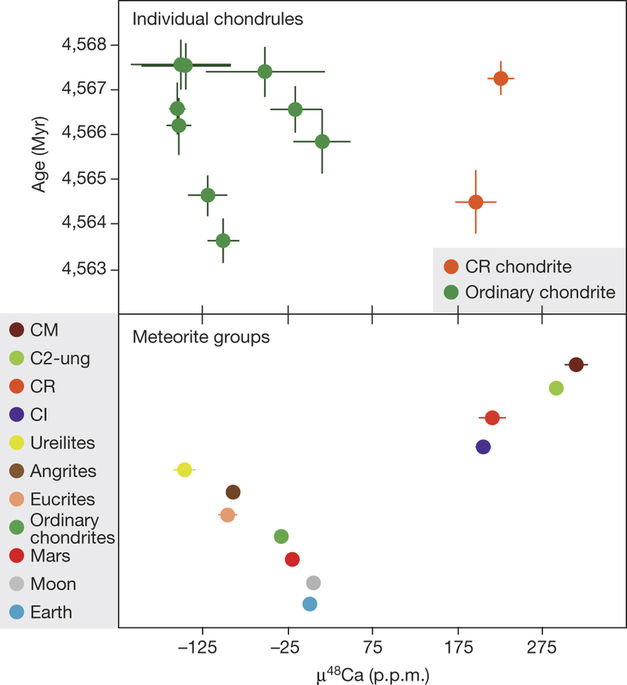Our official English website, www.x-mol.net, welcomes your feedback! (Note: you will need to create a separate account there.)
Isotopic evolution of the protoplanetary disk and the building blocks of Earth and the Moon
Nature ( IF 64.8 ) Pub Date : 2018-03-22 , DOI: 10.1038/nature25990 Martin Schiller 1 , Martin Bizzarro 1 , Vera Assis Fernandes 2, 3
Nature ( IF 64.8 ) Pub Date : 2018-03-22 , DOI: 10.1038/nature25990 Martin Schiller 1 , Martin Bizzarro 1 , Vera Assis Fernandes 2, 3
Affiliation

|
Nucleosynthetic isotope variability among Solar System objects is often used to probe the genetic relationship between meteorite groups and the rocky planets (Mercury, Venus, Earth and Mars), which, in turn, may provide insights into the building blocks of the Earth–Moon system. Using this approach, it has been inferred that no primitive meteorite matches the terrestrial composition and the protoplanetary disk material from which Earth and the Moon accreted is therefore largely unconstrained. This conclusion, however, is based on the assumption that the observed nucleosynthetic variability of inner-Solar-System objects predominantly reflects spatial heterogeneity. Here we use the isotopic composition of the refractory element calcium to show that the nucleosynthetic variability in the inner Solar System primarily reflects a rapid change in the mass-independent calcium isotope composition of protoplanetary disk solids associated with early mass accretion to the proto-Sun. We measure the mass-independent 48Ca/44Ca ratios of samples originating from the parent bodies of ureilite and angrite meteorites, as well as from Vesta, Mars and Earth, and find that they are positively correlated with the masses of their parent asteroids and planets, which are a proxy of their accretion timescales. This correlation implies a secular evolution of the bulk calcium isotope composition of the protoplanetary disk in the terrestrial planet-forming region. Individual chondrules from ordinary chondrites formed within one million years of the collapse of the proto-Sun reveal the full range of inner-Solar-System mass-independent 48Ca/44Ca ratios, indicating a rapid change in the composition of the material of the protoplanetary disk. We infer that this secular evolution reflects admixing of pristine outer-Solar-System material into the thermally processed inner protoplanetary disk associated with the accretion of mass to the proto-Sun. The identical calcium isotope composition of Earth and the Moon reported here is a prediction of our model if the Moon-forming impact involved protoplanets or precursors that completed their accretion near the end of the protoplanetary disk’s lifetime.
中文翻译:

原行星盘的同位素演化以及地球和月球的组成部分
太阳系天体之间的核合成同位素变异性通常被用来探测陨石群与岩石行星(水星、金星、地球和火星)之间的遗传关系,这反过来又可以提供对地月系统组成部分的见解. 使用这种方法,可以推断出没有原始陨石与地球成分相匹配,因此地球和月球所吸积的原行星盘材料在很大程度上不受约束。然而,这一结论是基于这样一个假设,即观察到的太阳系内部物体的核合成变异性主要反映了空间异质性。在这里,我们使用难熔元素钙的同位素组成来表明,太阳系内部的核合成变异性主要反映了与早期质量吸积到原太阳相关的原行星盘固体的与质量无关的钙同位素组成的快速变化。我们测量了来自于 ureilite 和 angrite 陨石的母体以及灶神星、火星和地球的样品的与质量无关的 48Ca/44Ca 比率,发现它们与其母小行星和行星的质量呈正相关,这是它们吸积时间尺度的代表。这种相关性意味着类地行星形成区域中原行星盘的大量钙同位素组成的长期演化。在原太阳坍缩后一百万年内形成的普通球粒陨石中的单个球粒揭示了太阳系内部与质量无关的 48Ca/44Ca 比率的全部范围,表明原行星盘的材料组成发生了快速变化. 我们推断,这种长期演化反映了原始太阳系外物质混合到经过热处理的内部原行星盘中,这与原太阳质量的增加有关。这里报道的地球和月球相同的钙同位素组成是我们模型的预测,如果月球形成的影响涉及原行星或在原行星盘寿命末期完成吸积的前体。表明原行星盘的物质成分发生了快速变化。我们推断,这种长期演化反映了原始太阳系外物质混合到经过热处理的内部原行星盘中,这与原太阳质量的增加有关。这里报道的地球和月球相同的钙同位素组成是我们模型的预测,如果月球形成的影响涉及原行星或在原行星盘寿命末期完成吸积的前体。表明原行星盘的物质成分发生了快速变化。我们推断,这种长期演化反映了原始太阳系外物质混合到经过热处理的内部原行星盘中,这与原太阳质量的增加有关。这里报道的地球和月球相同的钙同位素组成是我们模型的预测,如果月球形成的影响涉及原行星或在原行星盘寿命末期完成吸积的前体。
更新日期:2018-03-22
中文翻译:

原行星盘的同位素演化以及地球和月球的组成部分
太阳系天体之间的核合成同位素变异性通常被用来探测陨石群与岩石行星(水星、金星、地球和火星)之间的遗传关系,这反过来又可以提供对地月系统组成部分的见解. 使用这种方法,可以推断出没有原始陨石与地球成分相匹配,因此地球和月球所吸积的原行星盘材料在很大程度上不受约束。然而,这一结论是基于这样一个假设,即观察到的太阳系内部物体的核合成变异性主要反映了空间异质性。在这里,我们使用难熔元素钙的同位素组成来表明,太阳系内部的核合成变异性主要反映了与早期质量吸积到原太阳相关的原行星盘固体的与质量无关的钙同位素组成的快速变化。我们测量了来自于 ureilite 和 angrite 陨石的母体以及灶神星、火星和地球的样品的与质量无关的 48Ca/44Ca 比率,发现它们与其母小行星和行星的质量呈正相关,这是它们吸积时间尺度的代表。这种相关性意味着类地行星形成区域中原行星盘的大量钙同位素组成的长期演化。在原太阳坍缩后一百万年内形成的普通球粒陨石中的单个球粒揭示了太阳系内部与质量无关的 48Ca/44Ca 比率的全部范围,表明原行星盘的材料组成发生了快速变化. 我们推断,这种长期演化反映了原始太阳系外物质混合到经过热处理的内部原行星盘中,这与原太阳质量的增加有关。这里报道的地球和月球相同的钙同位素组成是我们模型的预测,如果月球形成的影响涉及原行星或在原行星盘寿命末期完成吸积的前体。表明原行星盘的物质成分发生了快速变化。我们推断,这种长期演化反映了原始太阳系外物质混合到经过热处理的内部原行星盘中,这与原太阳质量的增加有关。这里报道的地球和月球相同的钙同位素组成是我们模型的预测,如果月球形成的影响涉及原行星或在原行星盘寿命末期完成吸积的前体。表明原行星盘的物质成分发生了快速变化。我们推断,这种长期演化反映了原始太阳系外物质混合到经过热处理的内部原行星盘中,这与原太阳质量的增加有关。这里报道的地球和月球相同的钙同位素组成是我们模型的预测,如果月球形成的影响涉及原行星或在原行星盘寿命末期完成吸积的前体。



























 京公网安备 11010802027423号
京公网安备 11010802027423号